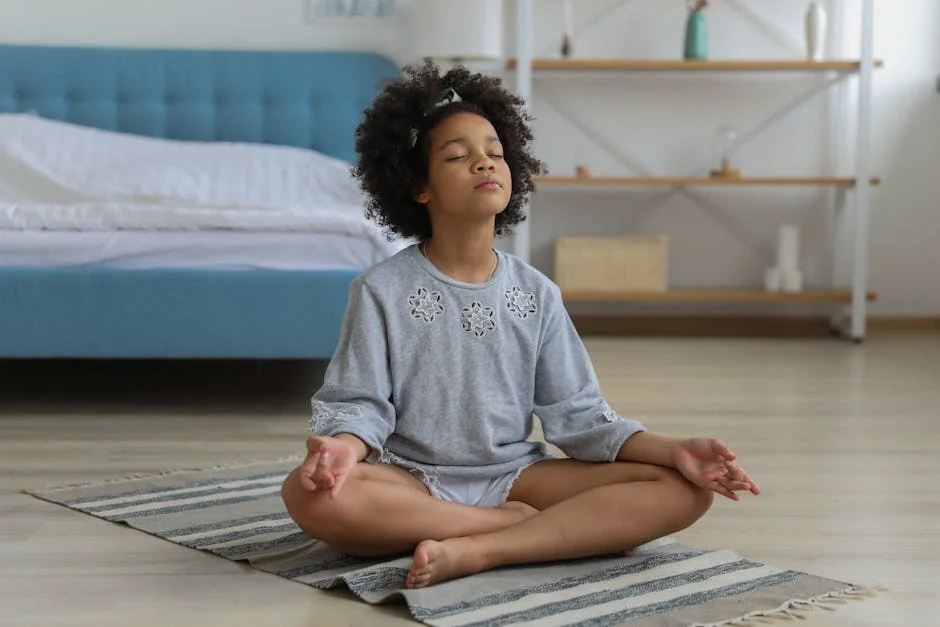Does your mind feel like a browser with too many tabs open? In our non-stop world, finding a moment of quiet can feel impossible. You've likely heard that meditation is the answer, but the idea of "clearing your mind" can seem intimidating, confusing, or just another item for your endless to-do list. If you're wondering what the best way to learn how to meditate truly is, you're in the right place. This guide is designed to cut through the confusion and provide a clear, actionable path for absolute beginners.
We're going to demystify the practice, showing you that meditation isn't about stopping your thoughts but learning to observe them without judgment. In the following sections, we’ll walk you through simple, foundational techniques, show you how to build a sustainable habit (even on your busiest days), and tackle the common challenges every beginner faces. Your journey to a calmer, more focused mind starts right here.
Understanding the Foundation: What is Meditation, Really?
Many people believe meditation is about emptying your mind of all thoughts, but this is the most common misconception. In reality, meditation is the simple practice of training your attention and awareness. It’s not about stopping thoughts, but rather learning to observe them as they come and go without getting swept away by them.
Think of it as a workout for your mind. Regular practice offers profound benefits, including:
- Reduced stress and anxiety
- Improved focus and concentration
- Better emotional regulation
- Increased self-awareness
It's crucial to set realistic expectations. Your mind will wander—this is normal and inevitable. The practice lies in gently bringing it back, just like you would with a straying puppy. It’s a skill that deepens with consistent practice.
The Best Way to Learn How to Meditate: Core Techniques for Beginners
The best way to learn how to meditate is to try a few simple techniques and see what feels most natural for you. Here are three foundational practices that offer some of the best ways to learn meditation.
Focused Attention (Breath Awareness)
This is the cornerstone of many meditation practices.
- Find a comfortable seated position, either on a chair or cushion, with your back relatively straight.
- Gently close your eyes or soften your gaze.
- Bring your attention to the physical sensation of your breath. Notice the air moving in and out of your nostrils, or the rise and fall of your chest or belly.
- Your mind will wander. When you notice it has drifted—to a sound, a thought, or a bodily sensation—simply and kindly acknowledge it, and guide your focus back to your breath. This act of noticing and returning is the meditation.
Body Scan Meditation
This technique is excellent for grounding yourself and releasing physical tension.
- You can lie down or sit comfortably. Close your eyes.
- Bring your awareness to the toes of your left foot. Notice any sensations there—tingling, warmth, or the feeling of your sock.
- Slowly move your attention up through your left foot, ankle, calf, and knee, then repeat the process with your right leg.
- Continue scanning systematically up through the rest of your body—torso, arms, hands, back, neck, and head—spending a few moments on each area.
Loving-Kindness Meditation
This practice focuses on cultivating feelings of compassion for yourself and others.
- Sit quietly and take a few calming breaths.
- Silently repeat a series of phrases directed at yourself, such as: "May I be happy. May I be healthy. May I be safe. May I live with ease."
- After a few minutes, bring to mind a loved one and direct the same phrases toward them: "May you be happy..."
- You can gradually extend these wishes to neutral people, and even to people you find difficult.
Creating a Sustainable Meditation Habit
Knowing how to meditate is one thing; making it a consistent habit is another. The key is to build a routine that feels manageable, not overwhelming.
- Start Small, Think Big: Begin with just 5-10 minutes per day. Consistency is far more important than duration. A short, daily practice is more effective than an hour once a week.
- Choose a Consistent Time and Place: Try to meditate at the same time and in the same quiet spot each day. This builds a powerful associative habit. First thing in the morning is often ideal, but you can discover the best time to meditate for your own schedule.
- The Power of Posture: You don’t need to sit in a perfect lotus position. Sit in a chair with your feet flat on the floor, or on a cushion with your hips slightly elevated. The goal is a posture that is both alert and relaxed.
- Using Guided Meditations: One of the best ways to learn meditation as a beginner is to use guided sessions from apps or online videos. They provide structure and verbal cues that keep you anchored. If you're looking for resources, you can even learn how to meditate for free with many excellent online options.
Overcoming Common Meditation Challenges
Every meditator faces hurdles. Anticipating them can help you move past frustration.
"My Mind Won't Stop Wandering." This is not a sign of failure; it is the entire point of the practice. Each time you notice your mind has wandered and gently guide it back, you are strengthening your "attention muscle." It is the repetition of this process that creates the benefit.
Dealing with Impatience and Restlessness If you feel fidgety or impatient, simply acknowledge the feeling with a neutral label, like "restlessness" or "impatience." Observe the physical sensations of that emotion in your body without trying to make it go away. It will eventually pass.
Falling Asleep If you frequently doze off, try meditating in an upright seated position rather than lying down. You can also meditate with your eyes slightly open or choose a time of day when you are more alert, like the morning.
"I Don't Have Enough Time." This is the most common challenge. Reframe your thinking: see meditation not as another task, but as a tool that makes the rest of your time more productive and peaceful. Those five minutes you "lose" will be repaid with greater focus and calm throughout your day. For more tips on fitting it into your life, our guide on how to meditate for beginners at home can be very helpful.
Embarking on the journey of meditation is a profound step toward greater mental clarity and emotional resilience. The most effective path to learning is not one of rigid perfection but of gentle, consistent practice. Begin with short, manageable sessions, focusing on the simple act of anchoring your attention to the breath. When the mind inevitably wanders, as it will, meet that moment with kindness and without judgment, gently guiding your focus back. This is the core practice. Consistency is far more critical than duration; a daily five-minute session will yield greater benefits than an infrequent hour. Remember, the goal is not to empty the mind but to become a more compassionate observer of its flow. The true transformation occurs not only during the sit but as you carry that cultivated awareness into your daily life. Start today, find a quiet moment, and take that first, simple breath. Your journey toward a calmer, more centered self is waiting to begin, one mindful moment at a time.



